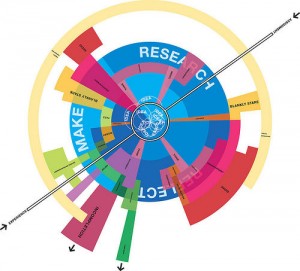by Townsend Wardlaw
When I begin a relationship with a new company, it doesn’t take long for people to get the sense that I am a ‘process’ guy. I place the term ‘process’ in quotes because I believe it is often misused and even more often misunderstood. Most of the time, coming on board as a ‘process’ guy generates equal amounts of euphoria and dread – both of which are unnecessary and usually a result of bias – for or against – process.
One of my mentors said: ‘We live our lives through our language’ and I believe the key to working well together is alignment of language. With that in mind, I wanted to share my definition and perspective on ‘process.’ Your thoughts/comments are always greatly appreciated.
To begin, lets start with a simple definition: A ‘process’ represents an agreed upon way of performing work (pretty simple huh?)
The goal of any ‘process’ is to ensure repeatability, measurement, improvement, and fault tolerance of that work function. The first three goals are pretty obvious but I believe the concept of fault-tolerance deserves some explaining as it is critical to long term
organizational growth.
To embrace the concept of fault tolerance, think about the electrical wiring in your home. If for some reason one of your outlets or circuits blows (either because of a malfunction or perhaps being over-loaded) what happens? Does your entire house go dark? Do you shut down the entire neighborhood?
Of course not. The problem is isolated and in most cases the remedy is straightforward (reset the circuit breaker!)
In my view, a ‘process’ must be documented (written down) to even be considered a ‘process.’ Undocumented processes are called ideas or concepts. They may be effective or even brilliant but they are difficult to share. We refer to the document used to describe a process as a ‘Process Document’ (very creative) and these typically include six sections or elements:
1) Overview – Every process document should begin by describing the process in 2 or 3 sentences that your mother would understand.
2) Workflow ‘Map’ – This is a one-page visual representation of what is going on. It is a great place to start, because it helps everyone quickly see how work moves (flows) through the system as well as identify bottlenecks.
3) Major Components – This is the ‘meat’ of any process document. Workflow Maps can get pretty intricate. However, in most cases, you really only need to define and describe 4 or 5 critical elements. For example, a process document for sales might contain the following major components:
- Prospecting (finding, contacting and scheduling an initial meeting with a prospect)
- Needs Assessment (understanding of customer pain and their buying process)
- Solution Presentation (articulation of specific customer benefit as well as demonstration of product)
- Proposal (development of a solution configuration and presentation of specifically how we plan to help them)
- Negotiation and Contracting (the external and internal elements necessary to bring a deal to closure)
4) Interface Points – While the Major Components section describes how we will perform the most important aspects of the process, Interface Points describe specific hand-offs both within the process map (from prospecting to Needs Assessment) and between other processes (from sales to implementation)
5) Audit and Measurement – This section is obviously about metrics that will be used to assess the process. In short, it must answer 3 questions
- How will you know the process is actually being performed as intended?
- How will you determine that the process is producing the desired output or results?
- How will you identify and prioritize areas for improvement
6) Tools – This section takes a broad view of the word ‘tools’ and uses it to catalogue and describe almost anything that is necessary to perform the work. This includes, but is in no way limited to, documentation, user guides, training, technology, calendars, cheat-sheets, and sub-process documents.
photo by: tinyproletariat
Townsend Wardlaw has worked for start ups, massive corporations, and founded and ran a successful sales consulting and outsourcing company for seven years–but he has always been passionate about sales and music. These days, you can find him working with individuals and companies alike, helping them to be truly motivated to change, grow, and accomplish amazing things. Check out his other blog writings here! We think they’re pretty great.
Teneo Talent offers a new process of sales recruiting that uses sales assessments for both employers and job seekers to create long term fits. We also offer career development tools through our sales career coaching program, including resume writing. We offer career advice, career matching and although our organization has a national focus, and have many Denver and Boulder sales jobs available at the moment.



